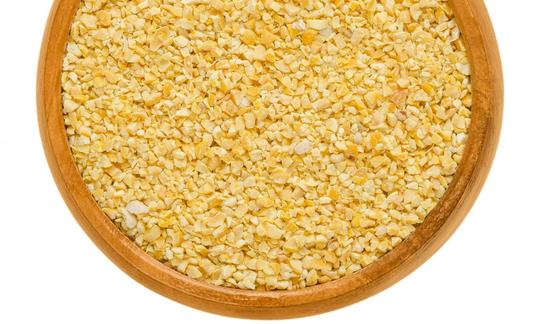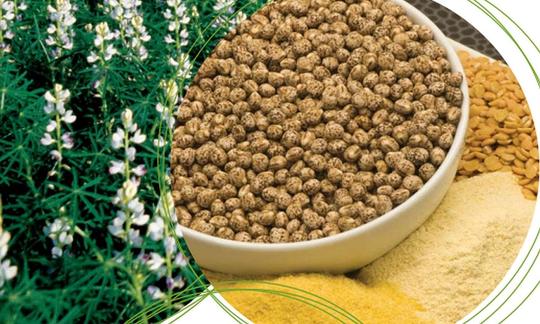Table of contents
For the production of raw lupine meal or sweet lupine meal, the seeds of the cultivated and therefore non-toxic sweet lupine ( Lupinus L. ssp.) or wolf bean are used.
Use in the kitchen:
What is lupin meal? Lupin meal is made from whole, peeled lupin seeds that are roughly crushed in a roller. Lupin meal is raw, gluten-free, grainy to the bite and has a sweet, grainy to nutty taste. One advantageous aspect of sweet lupins compared to wild varieties and some other legumes such as soybeans : sweet lupin products do not have any problematic ingredients.
Should you cook or soak lupine meal? It is not necessary to cook lupine meal or soak it. The protein-rich meal can be used without soaking in muesli or when preparing patties.
Preparing lupine meal: Other uses for sweet lupine meal include pre-cooking (approx. 5 minutes) and then soaking (10 minutes), which produces a type of porridge. Popular ways of preparing them include salads, tabbouleh and using them in Bolognese sauces or lasagne as a meat alternative. You should soak whole lupine seeds (overnight) and then cook them for approx. 2 hours. Even then, they are still very firm. You can also peel lupine seeds while they are cooked, similar to almonds or chickpeas.
Alternatively, you can create unheated spreads or sauces by letting around 100 g of groats soak in 250 ml of water for several hours (at least 3 hours) and then processing them further. In certain recipes, flour can also be replaced with lupine groats, although pure lupine flour is better suited for this.
A special lupin product known in the Mediterranean region is pickled lupin seeds, especially as a snack in restaurants (wolf beans). For vegan diets and products suitable for them, pure lupin protein (lupin protein isolate) is used to make milk substitutes such as yoghurt, cheese or ice cream; this protein has very little taste of its own. 1 Lupin tofu, a tofu-like product made from lupin flour, is also a particularly tasty source of protein. 2 The product marketed as "Lopino" is no longer available, however.
If you roast the fruit, you get a coffee-like drink (e.g. Altreier coffee). 3
Lupine meal recipes:
You can find recipes with lupine meal on the internet, such as suggestions for vegan lupine lasagne, cucumber lupine tabbouleh, lupine bolognese or vegan lupine bratilinge, lupine meal porridge, lupine yoghurt or milk, pickled lupines, tofu etc. Here is a vegan lupine meal recipe for lupine batlings:
Ingredients: 200 g lupin meal, 350 ml hot water , 130 g carrots , 60 g leeks , 30 g onions , 1 tbsp parsley (finely chopped), 20 g egg substitute (e.g. okara or aquafaba ), 60 ml cold water, 4 tbsp yeast flakes , sea salt ,pepper , 2 tbsp vegetable oil for frying (e.g. rapeseed oil ).
Preparation: Put the sweet lupin meal in a bowl and pour hot water over it, cover and leave to soak for 15-20 minutes. In the meantime, peel and finely grate the carrots, clean and wash the leek and finely chop it and the onion. Puree the vegetables together with the soaked lupin meal in a blender. If it is too dry, you can add about 5-6 tablespoons of vegetable stock. Pour the mixture into a bowl and mix the egg substitute mixed in cold water with the parsley and yeast flakes. Season with salt and pepper. Form about 12 patties from this amount and fry them on both sides in a pan drizzled with oil at a medium heat. This goes well with salad and dip, for example.
You can find more vegan lupin meal recipes under the note: " Recipes that have the most of this ingredient ".
| Not only vegans or vegetarians should read this: Vegans often eat unhealthily. Avoidable nutritional mistakes . |
Shopping - where to buy?
You will hardly find sweet lupin meal in supermarket chains such as Coop , Migros , Denner , Volg , Spar , Aldi , Lidl , Rewe , Edeka , Hofer etc. Lupin meal is available from Alnatura and Rapunzel. However, the products are not available in all shops that sell these brands. We discovered the Alnatura product at Edeka .
Lupins as a whole, as well as groats, flakes, flour or protein powder, are almost exclusively available in organic supermarkets ( Denn's Biomarkt ), organic shops, health food stores, drugstores or online. You can also buy organic lupin milk there. Processed products are more likely to go bad because the seed husks are destroyed. This is why they are often heated (toasted) and no longer raw! Such products made from blue or white sweet lupins are usually packaged in a 250 g bag.
At Migros we found lupin products from the brand Plant-based Alternative (Lupinen). They offer vegan cheese as a spread, to melt, grated and in chunks. Spar ( Interspar ) has the Made with LUVE brand and has an ice cream made from it in its range. Vegavita sells a vanilla ice cream made from lupins in Austrian Rewe shops ( Billa , Merkur , Adeg ), but you can find many additives in every ice cream. The German Rewe Group offers lupins pickled in salt water from the Macarico brand from Portugal.
When purchasing lupin meal, make sure it is organically produced to avoid unnecessary pesticide contamination.
Homemade preparation:
Making your own lupin meal is not so easy, because after harvesting and drying, the lupin seeds first have to be peeled to reduce the crude fiber content. This process usually takes place in a peeling mill. They are then crushed on a roller mill or ground in a grist mill. The fineness can usually be adjusted during crushing or sieving.
Found in the wild:
Wild forms of the cultivated white lupine ( Lupinus albus ) or lupini no longer exist. Only primitive forms ( L. graecus or L. termis ) are found. These bitter lupines contain significantly more bitter substances in the form of alkaloids (bitter lupine) than the sweet lupines used today. 4 Even in the wild species that bloom magnificently in gardens, all parts of the plant are poisonous. Occasionally, wild species of the blue or narrow-leaved lupine ( Lupinus angustifolius ) can be found.
Storage:
Lupine meal can be stored for several months if kept dry, dark and hermetically sealed. Toasted products last for up to a year. It is better to buy the whole grains and grind them when needed. Whole, germinable, i.e. "living" grains last for years.
Ingredients - Lupine meal nutritional values - Calories:
The calorie content of sweet lupine meal is approximately 371 kcal/100g. Carbohydrates make up the largest proportion at approximately 40%, closely followed by protein at approximately 36%. The fat content is not as high at 9.7% compared to soybeans (20%), but is still considerable. 5
Lupine contains all essential amino acids, such as threonine , isoleucine , tryptophan , leucine , lysine , valine , etc., and is therefore a popular source of protein, especially among vegetarians and vegans. Lupine protein has a similarly high biological value to soy protein. The high fiber content leads to a rapid feeling of satiety.
100 g of lupin meal contains around 355 µg of folic acid . This covers more than the average daily requirement. 6 The proportion in kidney beans is even higher at 394 µg/100g, as in many other pulses, but these are not edible raw. When cooked, the folic acid content of kidney beans is reduced to around 130 µg/100g. 5 Folate, a folic acid-active substance group, is a water-soluble vitamin and important for cell renewal.
The trace element manganese is also present in high amounts at 2.4 mg/100g. Millet , walnuts , almonds and uncooked white beans have similar values, around 2 mg/100g. Manganese is important for the formation of cartilage in the body.
Depending on the type of lupine, the shell content can be very high: the yellow lupine has about 30% shell content, the blue lupine 25% and the white lupine 15%. These seed shells are very hard and the fiber content of the seeds is still very high even without shell content. 7
Sweet lupins - those suitable for human consumption - should not exceed a maximum alkaloid content of 0.02%. 8
The complete ingredients of lupin meal, the coverage of the daily requirement and comparison values with other ingredients can be found in our nutrient tables. In the article Nutrients explained you will get a detailed insight into the topic.
Is lupine meal healthy? Aspects - Effects:
In contrast to other pulses, lupine seeds are very well tolerated and cause flatulence much less often. In addition, lupine is gluten-free and suitable for people with gluten intolerance or celiac disease. This is why lupine milk is also healthy. But 'healthy' or 'unhealthy' always depends on the quantity.
The alkaline protein in lupins causes less uric acid. This makes lupins ideal for people who need to eat a low-purine diet as a result of rheumatism or gout. 8
The low glycemic index (< 50) of sweet lupins leads to a slow increase in blood sugar levels, which makes them very well tolerated by people with diabetes. 8
Folk medicine - naturopathy:
In folk medicine, lupine seeds are known mainly thanks to Hildegard von Bingen (against intestinal problems, colic). 17 Today, naturopathy attributes anti-cancer, antioxidant and antimicrobial effects to lupine.
Dangers - intolerances - side effects:
Like all protein-rich foods, lupins have an increased allergy potential. 9 Some people develop a sensitization to lupin components. This allergy to certain proteins (conglutins) 10,11 can occur in isolation or as a cross-allergy (mostly in cases of sensitization to peanuts). 12,13
In addition to peanuts, there are also other cross-reactions with foods from the same botanical family, for example with chickpeas and beans. The problem here is the current obligation to declare lupins as an ingredient, which does not apply equally in all countries. In many European countries there is a special labelling requirement - even for the smallest quantities or for components of lupins and products derived from them. 14
Does lupin meal taste bitter? Wild lupins or garden lupins contain lupinine. This poisonous bitter substance of the quinolizidine alkaloids causes respiratory paralysis and can, in the worst case, lead to death. The lupins available today are non-toxic cultivated forms and no longer taste bitter.
Occurrence - Origin:
There are about 300 species of the genus Lupinus , which originate from two main gene centers: one from the Mediterranean region, the other from the middle part of the west coast of North, Central and South America. 4
The following species are suitable for grain production through breeding measures: Both the white lupine ( Lupinus albus ) from the Mediterranean region and the Andean lupine ( Lupinus mutabilis ) from the high altitudes of the central and southern Andes have been cultivated by humans for thousands of years. It was not until the end of the 1920s that low-alkaloid sweet lupines were bred from the yellow lupine ( Lupinus luteus ) and the blue lupine ( Lupinus angustifolius ). 4 These are also suitable for cultivation in Germany, Austria and Switzerland, meaning that no imports are necessary.
Cultivation - Harvest:
The lupine is a herbaceous, mostly perennial (sometimes annual), undemanding plant that thrives on sandy and dry soils. Since lupines also grow very well on unfertilized soils, they are particularly suitable for organic farming. Lupines have very good soil-improving effects. As green manure, they enrich the soil with up to 100 kg of nitrogen per hectare. The nitrogen is bound from the air by the nodule bacteria that live in symbiosis on the roots of the Fabaceae. The roots, which can be up to 1.5 m long, loosen the soil and improve the rootability of the soil for subsequent crops. With lupines, a cultivation break of at least 4 years should be observed. 15
The plant grows to a height of between 80 and 120 cm, of which the thick flower candles can take up up to 50 cm. The flower color is white, violet, pink, red or yellow depending on the variety; there are also two-colored variants. The name of the lupine species is not always the same as the flower color. For example, the flower color of the narrow-leaved lupine (also called blue lupine) is very often white.
The lupine seeds are enclosed in pods. These contain several round or flattened, rough to smooth seeds. Depending on the variety, the seeds vary in size and the color can also vary. The blue or narrow-leaved lupine has smooth, gray-brown seeds with white spots (diameter approx. 7 mm), the multi-leaved lupine has spherical, grayish seeds with dark spots and the white lupine has flattened, white seeds, sometimes with black markings (diameter approx. 8-10 mm). 7
Blue lupins are usually harvested at the end of August. At this point, the storage moisture should be around 14%, and night drying is also necessary here. 16
A particular plant disease, anthracnose (scorch), is causing problems for organic lupin cultivation, especially white lupins. It is caused by fungi such as Colletotrichum acutatum or Glomerella cingulata . Varieties of blue lupin are resistant to this disease.
Animal protection - species protection - animal welfare:
When in bloom, lupins (wolf beans) are a great bee pasture and the nectar supply also attracts bumblebees.
General information:
The name lupine comes from the Latin "lupus" (wolf). This is why lupine is also known as wolf bean, sometimes it is also called fig bean. It is a genus of plants in the subfamily Faboideae within the legume family (Fabaceae or Leguminosae). This family also includes peas , chickpeas and peanuts .
By breeding lupin varieties with significantly lower levels of bitter substances and toxins (so-called sweet lupins), the use of lupins has been improved. The name sweet lupin does not, as one might think, indicate a sweet taste, but rather the lower amount of bitter substances compared to the original varieties. Well-known varieties are the multi-leaved lupin ( Lupinus polyphyllus ), the yellow lupin ( Lupinus luteus ), the white lupin ( Lupinus albus ) and the blue or narrow-leaved lupin ( Lupinus agnustifolius ). 3
Alternative names:
Sweet lupins or wolf beans are also called edible lupins. In English, sweet lupins are known as sweet lupins and peeled lupin seeds, which are always yellow in color, are sold under the name kernels. 7
Other uses:
Lupins are becoming increasingly popular in animal feed production and are becoming economically important, especially in organic farming. The high protein content of the local grain legumes can replace imported, often genetically modified soya. 2 For horses, leaves (e.g. of the multi-leaf lupin Lupus polyphyllus ) and especially lupin seeds with a high alkaloid content are not suitable as animal feed, as they are classified as poisonous to highly poisonous. Deaths have also been reported. In cows, too, eating wild lupins that are grown as green manure in the field can lead to gastrointestinal complaints, restlessness, shortness of breath, tremors and even skeletal deformities in calves.
Literature - Sources:











Comments